In Silico Analysis of Anti-Inflammatory and Antioxidant Properties of Bioactive Compounds from Crescentia cujete L.
Abstract
1. Introduction
2. Results
2.1. ADME Prediction
2.2. Molecular Docking
3. Materials and Methods
3.1. ADME Prediction
3.2. Molecular Docking
3.3. Retrieval of Protein Structure
3.4. Retrieval of Ligands
3.5. Grid Preparation and Molecular Docking
4. Discussion
5. Conclusions
Supplementary Materials
Author Contributions
Funding
Institutional Review Board Statement
Informed Consent Statement
Data Availability Statement
Acknowledgments
Conflicts of Interest
Sample Availability
References
- He, G.; Karin, M. NF-κB and STAT3–key players in liver inflammation and cancer. Cell Res. 2011, 21, 159–168. [Google Scholar] [CrossRef] [PubMed]
- Nwogwugwu, N.U.; Abu, G.O.; Akaranta, O. Chemical composition of calabash (Cresentia cujete) and fluted pumpkin (Telfaria occidentalis Hook. F) Pulp and their potential for use in the industry. Arch. Appl. Sci. Res. 2016, 8, 24–30. [Google Scholar]
- Roy, A.; Khan, A.; Ahmad, I.; Alghamdi, S.; Rajab, B.S.; Babalghith, A.O.; Alshahrani, M.Y.; Islam, S.; Islam, M.R. Flavonoids a bioactive compound from medicinal plants and its therapeutic applications. Biomed. Res. Int. 2022, 2022, 5445291. [Google Scholar] [CrossRef] [PubMed]
- Abdelhameed, R.F.A.; Ibrahim, A.K.; Elfaky, M.A.; Habib, E.S.; Mahamed, M.I.; Mehanna, E.T.; Darwish, K.M.; Khodeer, D.M.; Ahmed, S.A.; Elhady, S.S. Antioxidant and anti-inflammatory activity of Cynanchum acutum L. isolated flavonoids using experimentally induced type 2 diabetes mellitus: Biological and in silico investigation for nf-κb pathway/mir-146a expression modulation. Antioxidants 2021, 10, 1713. [Google Scholar] [CrossRef]
- Batiha, G.E.-S.; Beshbishy, A.M.; Ikram, M.; Mulla, Z.S.; El-Hack, M.E.A.; Taha, A.E.; Algammal, A.M.; Elewa, Y.H.A. The pharmacological activity, biochemical properties, and pharmacokinetics of the major natural polyphenolic flavonoid: Quercetin. Foods 2020, 9, 374. [Google Scholar] [CrossRef]
- Lan, X.; Wang, W.; Li, Q.; Wang, J. The natural flavonoid pinocembrin: Molecular targets and potential therapeutic applications. Mol. Neurobiol. 2016, 53, 1794–1801. [Google Scholar] [CrossRef]
- Ejelonu, B.C.; Lasisi, A.A.; Olaremu, A.G.; Ejelonu, O.C. The chemical constituents of calabash (Crescentia cujete). Afr. J. Biotechnol. 2011, 10, 19631–19636. [Google Scholar] [CrossRef]
- Gonzales, A.L.; Sevilla, U.T.A.; Tsai, P.-W. Pharmacological Activities of Bioactive Compounds from Crescentia cujete L. Plant–A Review. Biointerface Res. Appl. Chem. 2022, 13, 197. [Google Scholar]
- Gonzales, A.; Sevilla, U.; Tsai, P.-W.; Huang, S. Antioxidant and anti-inflammatory activities of bioactive compounds from Crescentia cujete L. leaves and fruit–A review. Int. J. Adv. Appl. Sci. 2022, 9, 64–70. [Google Scholar] [CrossRef]
- Daina, A.; Michielin, O.; Zoete, V. SwissADME: A free web tool to evaluate pharmacokinetics, drug-likeness and medicinal chemistry friendliness of small molecules. Sci. Rep. 2017, 7, 42717. [Google Scholar] [CrossRef]
- Rana, S.; Dixit, S.; Mittal, A. In silico target identification and validation for antioxidant and anti-inflammatory activity of selective phytochemicals. Braz. Arch. Biol. Technol. 2019, 62. [Google Scholar] [CrossRef]
- Chen, D.; Oezguen, N.; Urvil, P.; Ferguson, C.; Dann, S.M.; Savidge, T.C. Regulation of protein-ligand binding affinity by hydrogen bond pairing. Sci. Adv. 2016, 2, e1501240. [Google Scholar] [CrossRef] [PubMed]
- Patil, R.; Das, S.; Stanley, A.; Yadav, L.; Sudhakar, A.; Varma, A.K. Optimized hydrophobic interactions and hydrogen bonding at the target-ligand interface leads the pathways of drug-designing. PLoS ONE 2010, 5, e12029. [Google Scholar] [CrossRef]
- Tomé, D. Amino acid metabolism and signalling pathways: Potential targets in the control of infection and immunity. Eur. J. Clin. Nutr. 2021, 75, 1319–1327. [Google Scholar] [CrossRef] [PubMed]
- Lindorff-Larsen, K.; Piana, S.; Palmo, K.; Maragakis, P.; Klepeis, J.L.; Dror, R.O.; Shaw, D.E. Improved side-chain torsion potentials for the Amber ff99SB protein force field. Proteins Struct. Funct. Bioinform. 2010, 78, 1950–1958. [Google Scholar] [CrossRef]
- Lipinski, C.A.; Lombardo, F.; Dominy, B.W.; Feeney, P.J. Experimental and computational approaches to estimate solubility and permeability in drug discovery and development settings. Adv. Drug Deliv. Rev. 2012, 64, 4–17. [Google Scholar] [CrossRef]
- Muegge, I.; Heald, S.L.; Brittelli, D. Simple selection criteria for drug-like chemical matter. J. Med. Chem. 2001, 44, 1841–1846. [Google Scholar] [CrossRef]
- Ghose, A.K.; Viswanadhan, V.N.; Wendoloski, J.J. A knowledge-based approach in designing combinatorial or medicinal chemistry libraries for drug discovery. 1. A qualitative and quantitative characterization of known drug databases. J. Comb. Chem. 1999, 1, 55–68. [Google Scholar] [CrossRef]
- Egan, W.J.; Merz, K.M.; Baldwin, J.J. Prediction of drug absorption using multivariate statistics. J. Med. Chem. 2000, 43, 3867–3877. [Google Scholar] [CrossRef]
- Veber, D.F.; Johnson, S.R.; Cheng, H.-Y.; Smith, B.R.; Ward, K.W.; Kopple, K.D. Molecular properties that influence the oral bioavailability of drug candidates. J. Med. Chem. 2002, 45, 2615–2623. [Google Scholar] [CrossRef]
- Oduselu, G.O.; Ajani, O.O.; Ajamma, Y.U.; Brors, B.; Adebiyi, E. Homology modelling and molecular docking studies of selected substituted benzo[d]imidazol-1-yl) methyl) benzimidamide scaffolds on Plasmodium falciparum adenylosuccinate lyase receptor. Bioinform. Biol. Insights 2019, 13, 1177932219865533. [Google Scholar] [CrossRef]
- Yadavalli, R.; Peasari, J.R.; Mamindla, P.; Praveenkumar; Mounika, S.; Ganugapati, J. Phytochemical screening and in silico studies of flavonoids from Chlorella pyrenoidosa. Inform. Med. Unlocked 2018, 10, 89–99. [Google Scholar] [CrossRef]
- Berman, H.M.; Battistuz, T.; Bhat, T.N.; Bluhm, W.F.; Bourne, P.E.; Burkhardt, K.; Feng, Z.; Gilliland, G.L.; Iype, L.; Jain, S.; et al. The Protein Data Bank. Acta Crystallogr. D Biol. Crystallogr. 2002, 58, 899–907. [Google Scholar] [CrossRef] [PubMed]
- Moulishankar, A.; Lakshmanan, K. Data on molecular docking of naturally occurring flavonoids with biologically important targets. Data Brief 2020, 29, 105243. [Google Scholar] [CrossRef]
- Johansson, M.U.; Zoete, V.; Michielin, O.; Guex, N. Defining and searching for structural motifs using DeepView/Swiss-PdbViewer. BMC Bioinform. 2012, 13, 173. [Google Scholar] [CrossRef]
- Trott, O.; Olson, A.J. AutoDock Vina: Improving the speed and accuracy of docking with a new scoring function, efficient optimization, and multithreading. J. Comput. Chem. 2010, 31, 455–461. [Google Scholar] [CrossRef] [PubMed]
- Sanner, M.F. Python: A programming Language for software integration and development. J. Mol. Graph. Model. 1999, 17, 57–61. [Google Scholar]
- Morris, G.M.; Huey, R.; Lindstrom, W.; Sanner, M.F.; Belew, R.K.; Goodsell, D.S.; Olson, A.J. Autodock4 and AutoDockTools4: Automated docking with selective receptor flexiblity. J. Comput. Chem. 2009, 30, 2785–2791. [Google Scholar] [CrossRef]
- Rivera-Mondragón, A.; Tuenter, E.; Ortiz, O.; Sakavitsi, M.E.; Nikou, T.; Halabalaki, M.; Caballero-George, C.; Apers, S.; Pieters, L.; Foubert, K. UPLC-MS/MS-based molecular networking and NMR structural determination for the untargeted phytochemical characterization of the fruit of Crescentia cujete (Bignoniaceae). Phytochemistry 2020, 177, 112438. [Google Scholar] [CrossRef]
- Daina, A.; Zoete, V. A boiled-egg to predict gastrointestinal absorption and brain penetration of small molecules. ChemMedChem 2016, 11, 1117–1121. [Google Scholar] [CrossRef] [PubMed]
- Alam, S.; Khan, F. 3D-QSAR, Docking, ADME/Tox studies on Flavone analogs reveal anticancer activity through Tankyrase inhibition. Sci. Rep. 2019, 9, 5414. [Google Scholar] [CrossRef]
- Pires, D.E.V.; Blundell, T.L.; Ascher, D.B. pkCSM: Predicting small-molecule pharmacokinetic and toxicity properties using graph-based signatures. J. Med. Chem. 2015, 58, 4066–4072. [Google Scholar] [CrossRef] [PubMed]
- Jain, A.K.; Singh, D.; Dubey, K.; Maurya, R.; Mittal, S.; Pandey, A.K. Models and methods for in vitro toxicity. In In Vitro Toxicology; Elsevier: Amsterdam, The Netherlands, 2018; pp. 45–65. [Google Scholar]
- Wu, H.; Yin, J.; Xiao, S.; Zhang, J.; Richards, M.P. Quercetin as an inhibitor of hemoglobin-mediated lipid oxidation: Mechanisms of action and use of molecular docking. Food Chem. 2022, 384, 132473. [Google Scholar] [CrossRef] [PubMed]
- Shaukat, A.; Hussain, K. Quercetin Based Standardization of Polyherbal Anti-Gout Remedy and Its Molecular Docking Study against Anti-Gout and Anti-Inflammatory Protein Targets. FABAD J. Pharm. Sci. 2022, 47, 317–330. [Google Scholar]
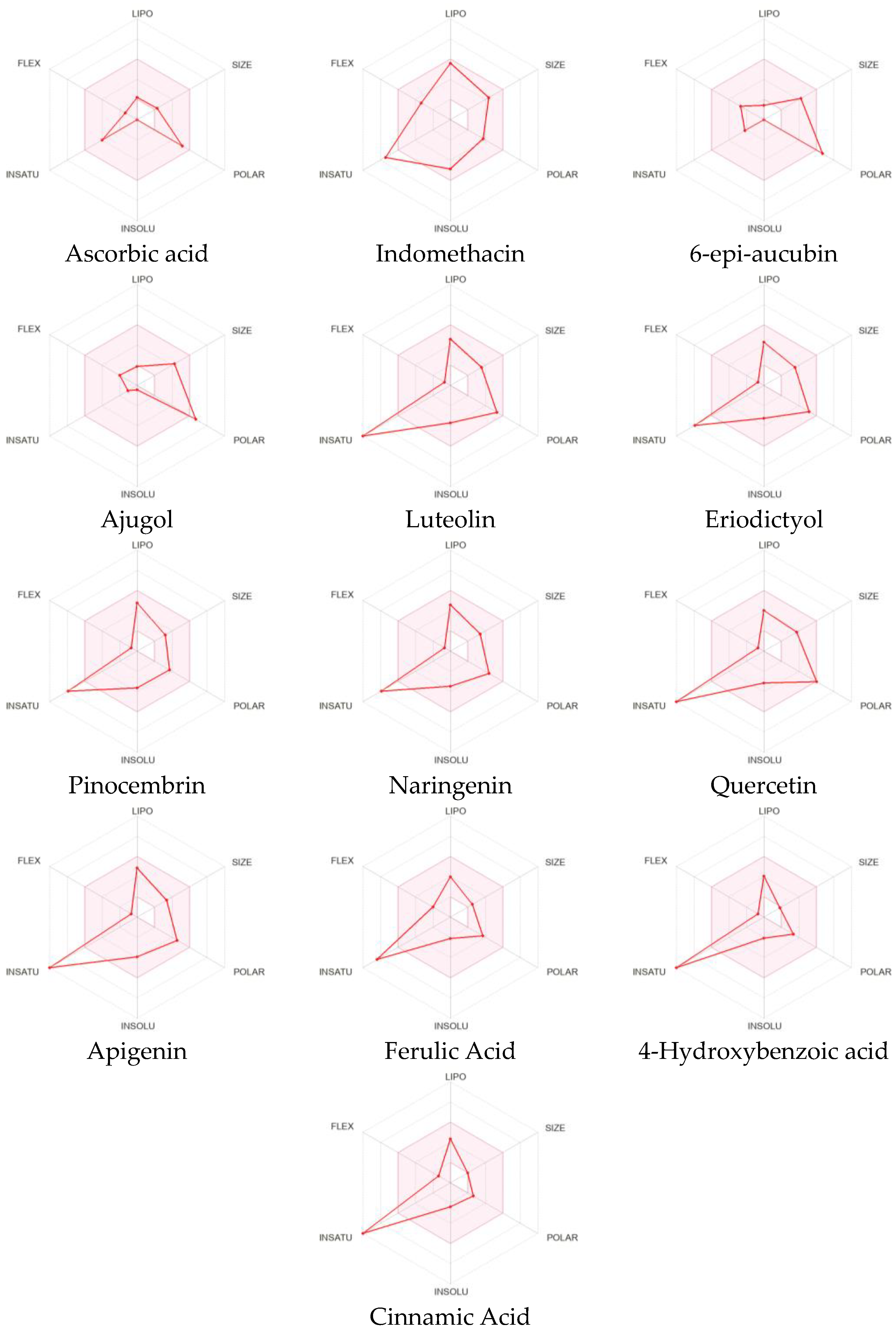
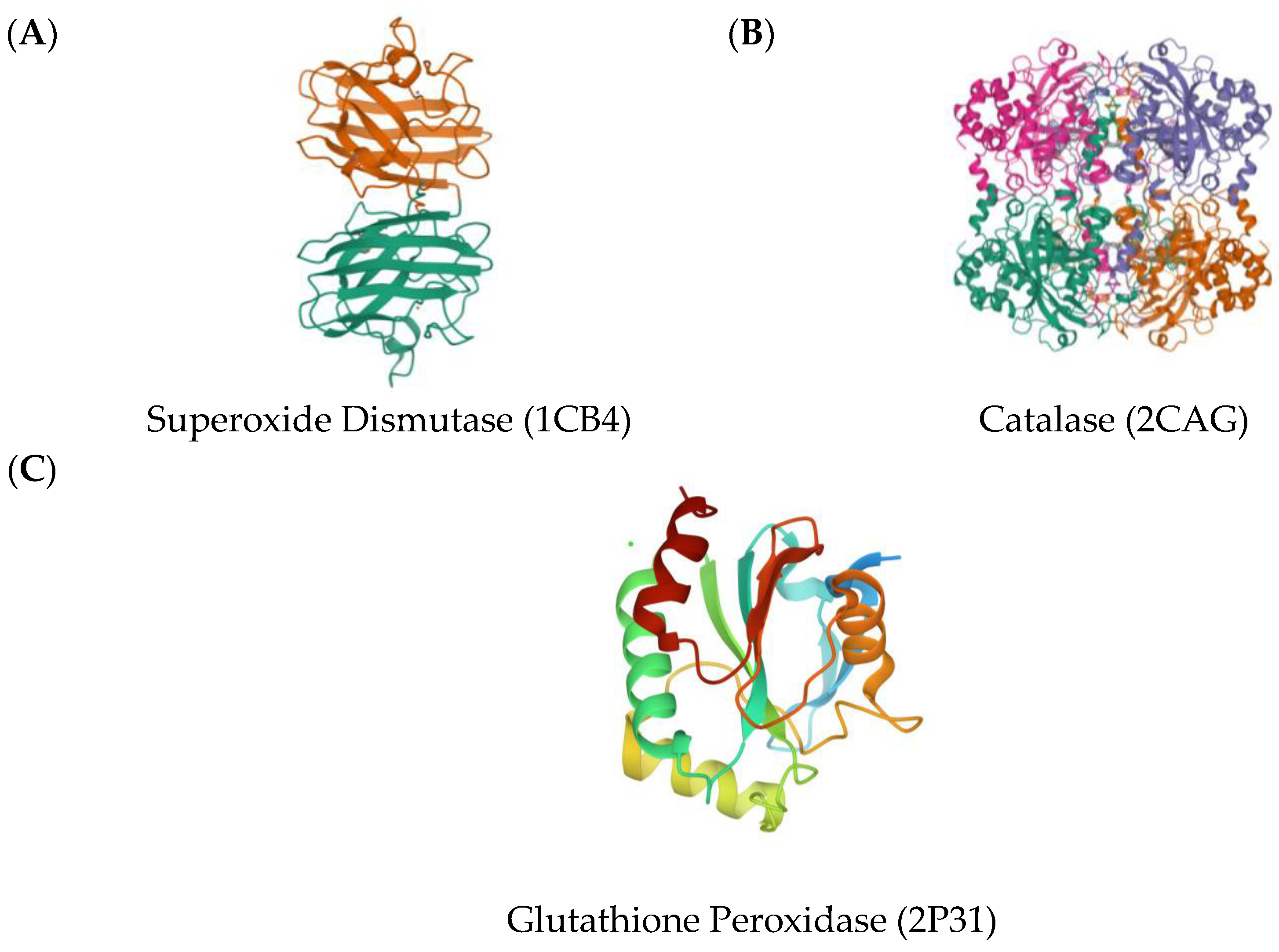

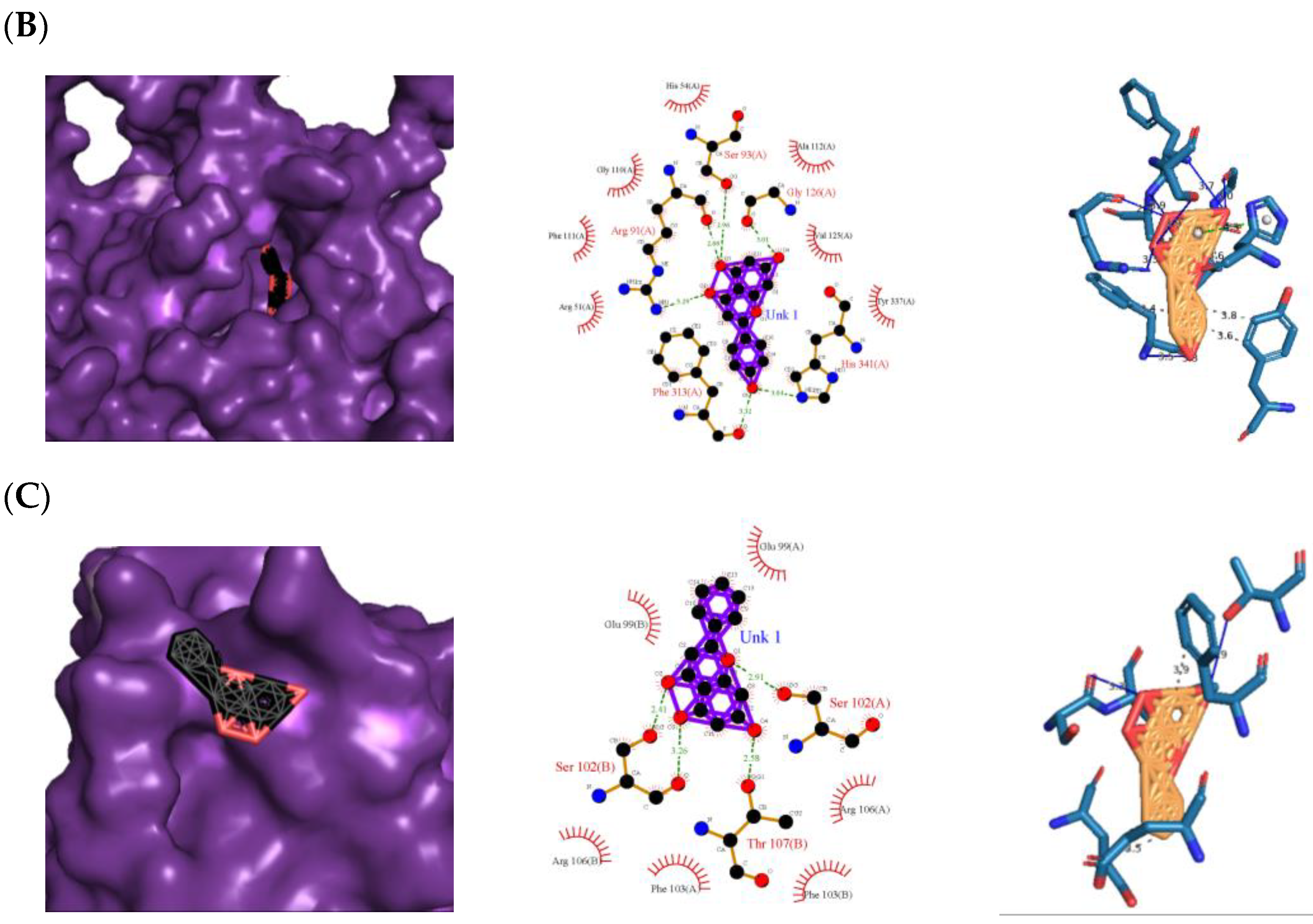

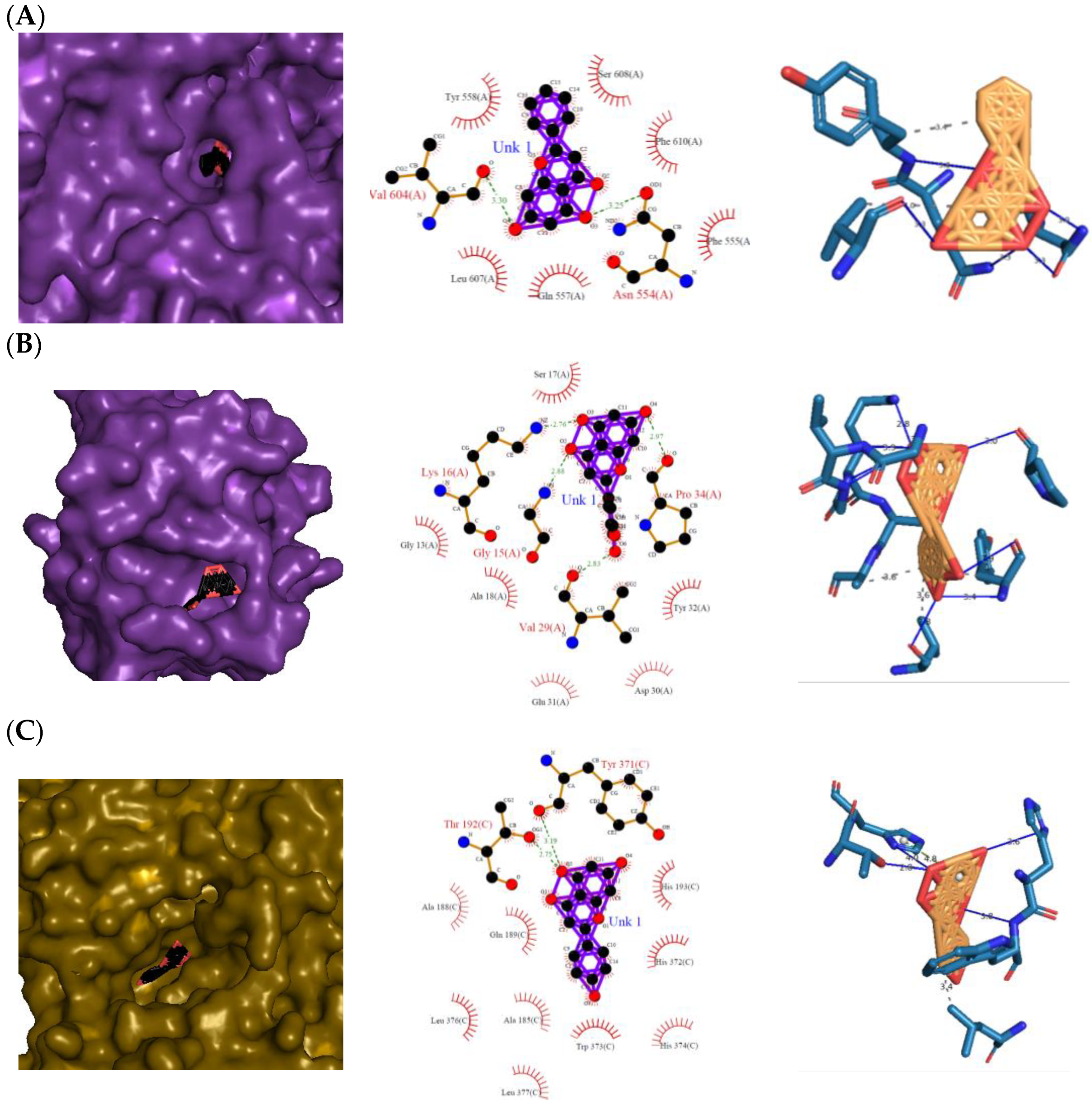
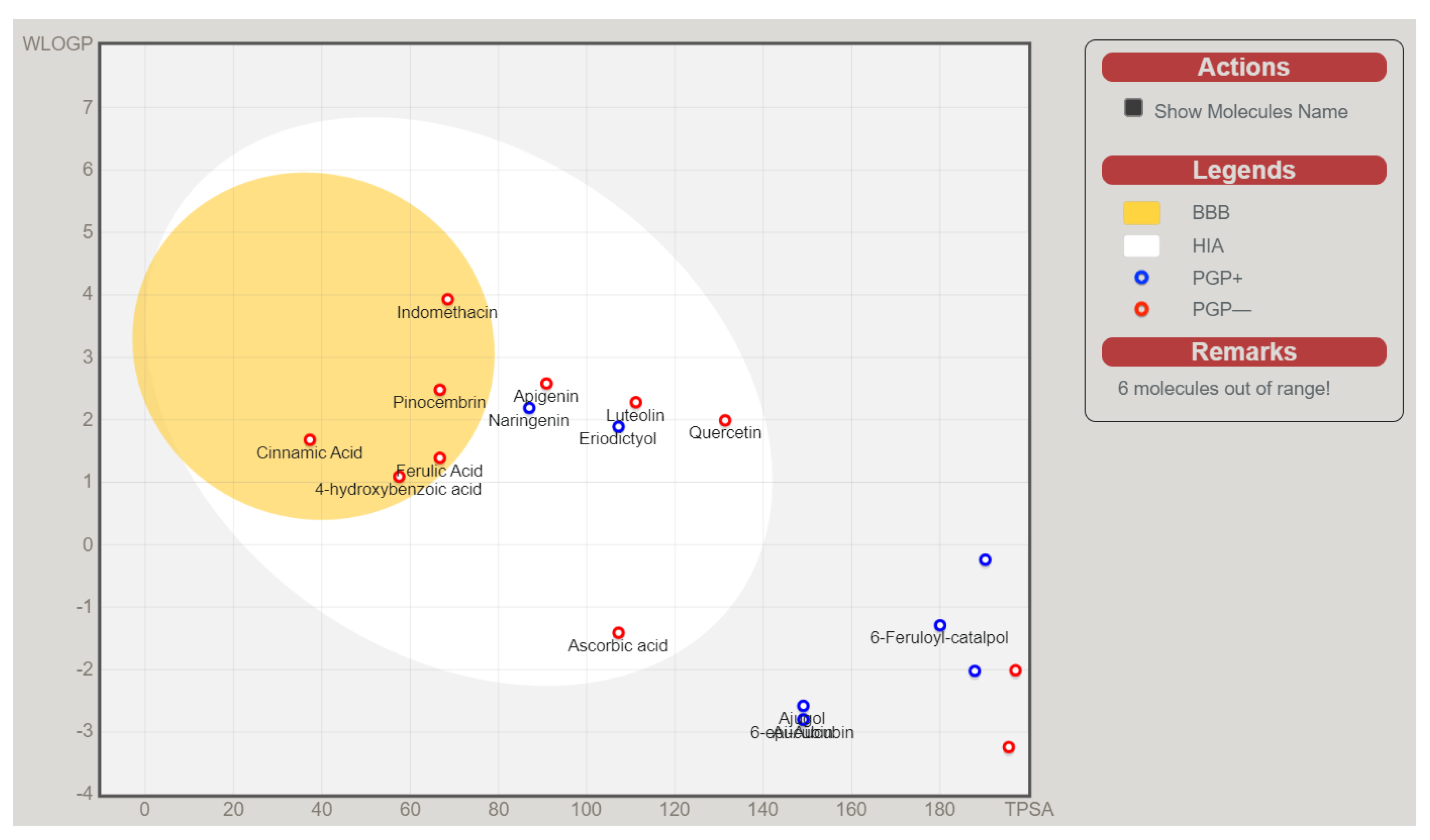
| 1CB4 | 2CAG | 2P31 | ||||
|---|---|---|---|---|---|---|
| Ligand | Naringenin | Ascorbic Acid | Naringenin | Ascorbic Acid | Pinocembrin | Ascorbic Acid |
| binding energy | −10.32 | −3.46 | −11.87 | −3.64 | −10.85 | −4.49 |
| ligand efficiency | −0.52 | −0.31 | −0.59 | −0.33 | −0.57 | −0.41 |
| inhib constant | 27.26 | 2.93 | 1.99 | 2.16 | 11.08 | 512.61 |
| inhib constant units | nM | mM | nM | mM | nM | uM |
| intermol energy | −11.21 | −4.65 | −12.77 | −5.13 | −11.45 | −5.68 |
| vdw hb desolv energy | −11.21 | −4.42 | −12.77 | −4.93 | −11.45 | −5.48 |
| electrostatic energy | 0 | −0.23 | 0 | −0.2 | 0 | −0.21 |
| total internal | −0.08 | −1.67 | −0.06 | −1.68 | −0.3 | −1.64 |
| torsional energy | 0.89 | 1.19 | 0.89 | 1.49 | 0.6 | 1.19 |
| unbound energy | −0.08 | −1.67 | −0.06 | −1.68 | −0.3 | −1.64 |
| cIRMS | 0 | 0 | 0 | 0 | 0 | 0 |
| refRMS | 69.76 | 72.15 | 58.64 | 63.49 | 28.98 | 28.06 |
| rseed1 | none | none | none | none | none | none |
| rseed2 | none | none | none | none | none | none |
| H-bond formed | 2 | 3 | 2 | 0 | 0 | 2 |
| 3V99 | 4L9S | 3LN0 | ||||
|---|---|---|---|---|---|---|
| Ligand | Pinocembrin | Indomethacin | Eriodictyol | Indomethacin | Naringenin | Indomethacin |
| binding energy | −11.29 | −8.31 | −10.39 | −9.47 | −11.96 | −11.22 |
| ligand efficiency | −0.59 | −0.33 | −0.49 | −0.38 | −0.6 | −0.45 |
| inhib constant | 5.29 | 804.47 | 24.39 | 113.87 | 1.72 | 6.01 |
| inhib constant units | nM | nM | nM | nM | nM | nM |
| intermol energy | −11.89 | −9.51 | −11.88 | −10.67 | −12.85 | −12.41 |
| vdw hb desolv energy | −11.89 | −9.51 | −11.88 | −10.67 | −12.85 | −12.41 |
| electrostatic energy | 0 | 0 | 0 | 0 | 0 | 0 |
| total internal | −0.3 | −1.54 | 14.93 | −1.45 | −0.08 | −1.25 |
| torsional energy | 0.6 | 1.19 | 1.49 | 1.19 | 0.89 | 1.19 |
| unbound energy | −0.3 | −1.54 | 14.93 | −1.45 | −0.08 | −1.25 |
| cIRMS | 0 | 0 | 0.25 | 0 | 0 | 0 |
| refRMS | 90.94 | 73.39 | 30.16 | 38.62 | 72.45 | 90.14 |
| rseed1 | none | none | none | none | none | none |
| rseed2 | none | none | none | none | none | none |
| H-bond formed | 2 | 2 | 4 | 4 | 2 | 0 |
| Drug/Ligand | Structure | Molecular Weight (g/mol) |
|---|---|---|
| Ascorbic Acid | 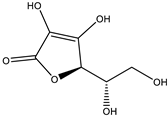 | 176.12 |
| Indomethacin |  | 357.79 |
| Luteolin | 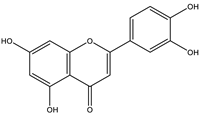 | 286.24 |
| Eriodictyol | 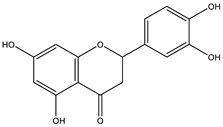 | 288.25 |
| Pinocembrin | 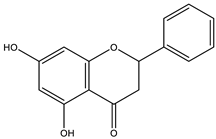 | 256.25 |
| Naringenin | 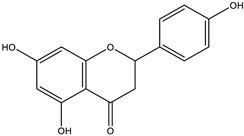 | 272.25 |
| Quercetin | 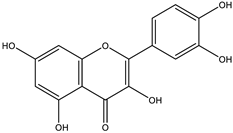 | 302.24 |
| Apigenin | 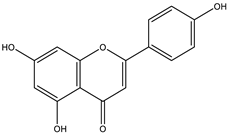 | 270.24 |
| Ferulic Acid | 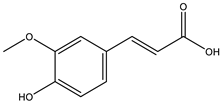 | 194.18 |
Disclaimer/Publisher’s Note: The statements, opinions and data contained in all publications are solely those of the individual author(s) and contributor(s) and not of MDPI and/or the editor(s). MDPI and/or the editor(s) disclaim responsibility for any injury to people or property resulting from any ideas, methods, instructions or products referred to in the content. |
© 2023 by the authors. Licensee MDPI, Basel, Switzerland. This article is an open access article distributed under the terms and conditions of the Creative Commons Attribution (CC BY) license (https://creativecommons.org/licenses/by/4.0/).
Share and Cite
Gonzales, A.L.; Huang, S.K.-H.; Sevilla, U.T.A.; Hsieh, C.-Y.; Tsai, P.-W. In Silico Analysis of Anti-Inflammatory and Antioxidant Properties of Bioactive Compounds from Crescentia cujete L. Molecules 2023, 28, 3547. https://doi.org/10.3390/molecules28083547
Gonzales AL, Huang SK-H, Sevilla UTA, Hsieh C-Y, Tsai P-W. In Silico Analysis of Anti-Inflammatory and Antioxidant Properties of Bioactive Compounds from Crescentia cujete L. Molecules. 2023; 28(8):3547. https://doi.org/10.3390/molecules28083547
Chicago/Turabian StyleGonzales, Alecsanndra L., Steven Kuan-Hua Huang, Ureah Thea A. Sevilla, Cheng-Yang Hsieh, and Po-Wei Tsai. 2023. "In Silico Analysis of Anti-Inflammatory and Antioxidant Properties of Bioactive Compounds from Crescentia cujete L." Molecules 28, no. 8: 3547. https://doi.org/10.3390/molecules28083547
APA StyleGonzales, A. L., Huang, S. K.-H., Sevilla, U. T. A., Hsieh, C.-Y., & Tsai, P.-W. (2023). In Silico Analysis of Anti-Inflammatory and Antioxidant Properties of Bioactive Compounds from Crescentia cujete L. Molecules, 28(8), 3547. https://doi.org/10.3390/molecules28083547









